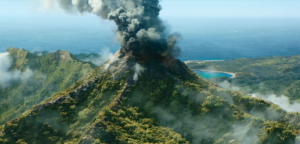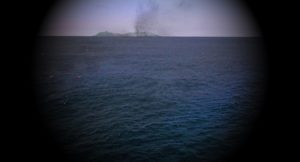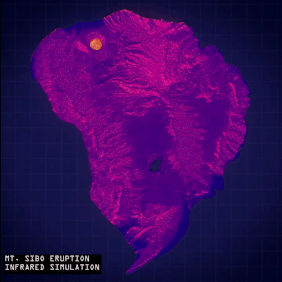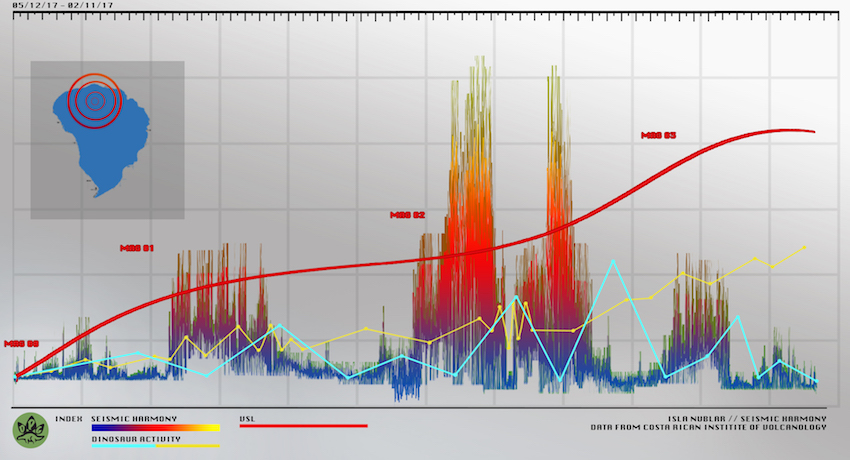
Mount Sibo is a stratovolcano located in the northwest of Isla Nublar. It was last known to be active in 1525, and remained dormant until it was reawakened by tectonic activity in February 2017. After almost five hundred years of dormancy, it erupted on June 23, 2018 and has maintained varying levels of activity since then. Because of its remote location, it is not of immediate concern with regards to human safety or economics, but it was at the center of de-extinct animal rights debates during its most recent activity.
Name
The name of Mount Sibo comes from Sibù, the creator deity in Bribri tradition.
InGen employees sometimes referred to the mountain as Mount Hammond, after John Hammond, rather than using the volcano’s native name. Masrani Global Corporation‘s official website referred to it as Mount Sibo, however, and from 2015 onward the original native name maintained popularity over the one given by Westerners.
Location

Mount Sibo is located in northern Isla Nublar. Its exact position is inconsistent between maps, but it is generally shown slightly to the northwest. According to a live feed from the Costa Rican Institute for Volcanology provided by the Dinosaur Protection Group, Mount Sibo is located at 10°24’50″N, 94°7’3″W. However, its location on geographic maps is closer to °48’11.4″N, 88°36’42.9″W. It is located in a mountain range near a large valley, just inland of the northwestern coast.
Description

Mount Sibo is a stratovolcano, meaning its steep conical shape is built up from volcanic debris deposited over multiple eruptions. Most of its composition is basaltic igneous rock, rich in iron; the high iron content in basaltic magma in this area can cause unusual magnetic activity. Basaltic magma is also high in calcium and magnesium, but poor in sodium and potassium. Its crater has varied in size over time, presumably along with levels of activity in the volcano itself. In 1993, when the volcano had been dormant for over four hundred years, its crater was smaller and mostly hidden by the mountain’s peak. Its summit was 2,058 feet above sea level as of 1993.
When the volcano was first recorded by Nicolas de Huelva in 1525, it was portrayed as being lower and less steep, though this may be a mistake on the part of the cartographer. The volcano was known to be active at the time of its discovery by Spanish explorers.
Mount Sibo, like most volcanoes, is riddled with lava tubes underneath. Some of these still had molten magma within as of 1993, but many were extinct, forming natural tunnels beneath the island. It is possible that some may have reached the ocean, as is fairly common with lava tunnels, and become flooded with either seawater or rainwater depending on their location; volcanic tunnels and craters often become the sites of rivers and lakes. As of 1993, new steam vents and lava rivers would sometimes occur, but the volcano itself remained inactive. The relative docility of Mount Sibo’s lava sources allowed InGen to use it for geothermal power in both Jurassic Park and Jurassic World. There were still incidents, however; the volcano was not entirely safe, and stringent security protocols were put in place to avoid sabotage or accidents.
Around Mount Sibo are geothermal vents which release heat and steam from beneath the island. According to Jurassic World: The Game, the ground around these geothermal vents can be hot enough to burn the skin off a person’s feet. Basaltic magma can usually range between 1,000 and 1,200 degrees Celsius (1,832 to 2,192 degrees Fahrenheit).

In 2017, tectonic activity opened up a fissure underneath Mount Sibo, granting it renewed access to a series of high-pressure magma chambers. This allowed magma to start rising though the volcano, while pressure continued to build underneath. By late 2017, small ruptures were occurring near the mountain’s summit, visible from the air as jets of lava escaping from the crater. By early 2018 a sizeable lava lake had formed, and the peak had crumbled due to extensive geological activity. This left the crater more exposed, and vegetation was dying back in the immediate active zone. On June 23, 2018, the volcano violently exploded due to this pent-up pressure. During the eruption, small explosions destroyed parts of the southwestern face before a large amount of the slope collapsed inward. Shortly after, a less violent collapse occurred on the eastern face due to lava melting the underlying rock.
History
Prehistory
Mount Sibo originated on the seafloor of the Cocos Plate, just to the west of a major subduction zone between it and the Caribbean Plate. Volcanic activity formed a seamount, gradually building up into what is now Isla Nublar. Without the activity of Mount Sibo, the island would not exist. However, as the island is not located on a plate boundary, it would not be continuously active. It would periodically become cut off from its supply of magma and go dormant for extended periods of time. The volcano’s size gradually increased with time, each eruption depositing more material which built up its steep slopes.
It is not currently known when Mount Sibo first formed, or how long Isla Nublar has existed. Because of its location, it is most likely around as old as Cocos Island, which formed about two million years ago.
1525 and earlier
According to dialogue in Jurassic Park: The Game given by Nima Cruz, the native Tun-Si people of Isla Nublar believed that the mountain was constructed by the animals of the world. The mountain resembles the conical house which, in Bribri culture, represents the universe and its many layers. The creator deity, Sibù, would reside at the top.

In 1525, Mount Sibo was actively producing volcanic smog due to a recent eruption. The plume of black smoke is believed to have been spotted by Nicolas de Huelva, cartographer for La Estrella, who named the island Isla Nublar (“Cloud Island”) for this reason. This immediately led to the discovery of the island by the Spanish. Volcanic debris from this eruption was scattered as far south as the central valley, but the eruption did not threaten the continued existence of the Tun-Si people or the island’s ecosystem.
1980s-1990s: Jurassic Park
During the 1980s, the native people of Isla Nublar were displaced and the volcano was utilized for geothermal power by InGen for Jurassic Park. A power plant was installed underneath the volcano’s western face, inside some of the more recent lava tubes; the plant was connected to the Park’s maintenance and service tunnel network. Active magma flows were present under the island at the time, but there was otherwise no indication of volcanic activity. Safety procedures surrounding the geothermal power plant were highly guarded. If a new steam vent or lava river was recorded, InGen would carefully monitor it for any signs of increasing volcanism. However, no major threats from the volcano were noted during Jurassic Park’s operation.

There were at least two incidents in the plant; one of unknown nature on May 24, 1993 and another on June 12, 1993 which involved a failure of the pressure release valves. This resulted in a dangerous uncontrolled steam pressure buildup which, according to Dr. Laura Sorkin, could have caused an explosion capable of destroying half of the island. Remaining staff and civilians on the island were able to prevent a steam explosion from occurring, and the power plant remained intact.
During this period of time, magnetic activity occurring around Isla Nublar made mapping difficult enough that the island was simply omitted from some maps.
2002-2015: Jurassic World
During the operational phase of Jurassic World, sixty-five percent of the power on Isla Nublar was taken from the geothermal activity within Mount Sibo. It is most likely that InGen refurbished the remains of the old power plant rather than go to the trouble of constructing a new one. The fact that it had not experienced a catastrophic steam explosion suggests that its pressure management systems had not failed again, or failed in such a way as to harmlessly release all of the pressure and allow the volcano’s natural processes to take over. There were no known incidents logged at the power plant during Jurassic World’s operation. Access to the plant was still highly limited, and was available almost exclusively through the North Mount Sibo Genetics Center elevator.
The geothermal power plant would have been shut down for the last time after the incident on December 22, 2015 which shut Jurassic World down due to bad publicity and financial issues. Jurassic World was abandoned, leaving the geothermal plant unmanaged. Systems in place prevented it from experiencing a catastrophic failure this time, and as the park slowly decayed, animals moved into the power plant. On the surface, geothermal vents were used as heat sources for dinosaurs looking to incubate their eggs.
2017-Present: Renewed activity
Tectonic activity in the Middle America Trench subduction zone occurred in early 2017, opening up fissures beneath Mount Sibo which reconnected it with a supply of magma. The Costa Rican Institute for Volcanology investigated this incident and filed a report in February, which reads: “A shift in the tectonic plates resulted in minor aftershocks throughout the rockbed, creating a relatively small fissure that caused a rise in heat beneath Mt. Sibo. The visible plumes of smoke are the result of plant life and other biological matter catching fire from the temperature change. There is no immediate threat to the island at this time.”
Some have speculated that geothermal drilling on the nearby Mantah Corp Island, which did trigger an earthquake in June 2016, may have contributed to the localized destabilization of the subduction zone beneath the Gulf of Fernandez.

In September, a private helicopter illegally flying over Isla Nublar approached the volcano. Passengers reported magma rupturing from the mountain’s peak. This prompted the CRIV to investigate further, using various methods such as harmonic tremor readings, infrared satellite scans, and seismic measurements. Mount Sibo was classified as active based on the results. Seismic measurements were less reliable due to interference from the impact tremors of large dinosaurs walking on the island.
On October 5, Mount Sibo’s volcanic status level (VSL) was set to MAG 3, or “Significant Activity.”

High-energy particle scans of the crust beneath Mount Sibo revealed the presence of magma chambers under intense stress. While the exact destructive power of the volcano could not be discerned, simulations suggested that temperature changes due to the eruption could cause the entire island to burn. According to a report published on February 4, 2018 by Franklin Webb of the Dinosaur Protection Group, the eruption could be one of the most destructive ever recorded.
Documentation provided by the DPG indicates that, between February 11, 2017 and May 12, 2017, Mount Sibo increased from a VSL of MAG 0 (“Dormant/Extinct”) to MAG 1 (“Light Activity”) and MAG 2 (“Moderate Activity”) before reaching the aforementioned MAG 3 classification, which it maintained for approximately a year. Harmonic resonance readings show two significant spikes in activity at the time MAG 2 was reached, in late March and early April. In general, spikes in volcanic activity also caused changes in dinosaur activity on the island, possibly due to magnetic effects caused by the large intrusion of iron-rich basaltic magma.

The DPG Twitter account reported increased activity on April 18, 2018, but its VSL was not updated by the CRIV. Increased activity was also reported on June 10, 2018, and similarly, the CRIV did not make an update to the volcano’s status.
On June 22, 2018, the CRIV reported Mount Sibo’s VSL as MAG 4 (“Eruption Imminent”), as the tremor readings were exceeding the eruption threshold.

Mount Sibo erupted on June 23, 2018 at approximately midday. The magma chamber was breached, causing a surge of magma which ruptured the volcano from the base upward. Lava bombs were ejected from the summit, and lava began to spread across the northern island. Several minutes later, the southeastern side of the volcano collapsed, unleashing a cloud of hot ash, gas, and dust which washed across the northeastern island. The heat of lava cascading down the mountain’s eastern face melted underlying rock, causing a less violent collapse of the east side which also caused an eruption of lava bombs and hot ash. Within an hour, most of the island was burning due to the spread of lava and airborne debris as well as the temperature changes caused by the eruption.
Based on the live feed presented on the Dinosaur Protection Group website, Mount Sibo remained continuously active with a VSL level of MAG 4 since its June 23 eruption until early 2022. Drone footage of the island as of that year revealed a decrease in activity, with no ash clouds or rupturing lava, and recovering plant life around the mountain and other parts of the northern island. The lava lake appears to still be present, but pressure from below has been relieved by the previous four years of activity.
Cultural Significance
The native Tun-Si tribe viewed Mount Sibo as a sacred place due to its appearance, which was similar to the conical house of Bribri tradition. The conical house represents the universe, separated into layers for each of its inhabitants; the creator deity resides at the top. According to Nima Cruz, the Tun-Si people believed that animals had constructed the mountain. It was, therefore, central to the spiritual beliefs of the Tun-Si.
Mount Sibo also had relevance in Western culture. It is theorized to have given Isla Nublar its name, meaning “Cloud Island” in Spanish, as it was active at the time of the island’s discovery by the carrack La Estrella in 1525. The volcano’s activity was directly responsible for Isla Nublar being discovered by Europeans.
It was utilized throughout the 1980s through the 2010s as a source of geothermal power by International Genetic Technologies, later under the wing of Masrani Global Corporation. As of June 1993, the geothermal plant was running at 30% capacity; when running at 80% capacity during Phase II of Park operation, it was estimated to be capable of producing twice the energy needs of the island. As of 2014, Masrani Global reported that 65% of the island’s power came from geothermal energy, a part of their campaign to reduce carbon emissions. However, the December 2015 incident at Jurassic World ended the use of Mount Sibo for this purpose.

From early 2017 until the volcano’s eruption on June 23, 2018, Mount Sibo was used as an icon for extinct animal rights by the Dinosaur Protection Group following the revelation that the volcano was becoming an active threat to the inhabitants of the island. A counteractive organization to the DPG, the Extinction Now! group, used the volcano as a logo to promote the extinction of genetically-modified organisms. However, the island was restricted to the public by U.S. and Costa Rican law, with shipping and flight routes redirected; only offshore research vessels were allowed near the island. Masrani Global Corporation still technically owned the island, but took no action to protect its inhabitants. The Costa Rican Environmental Protection Society also made no comment regarding the continued protection of the island, though the Costa Rican Department of Biological Preserves openly supported the DPG.

Threats from the eruption mostly involved local air traffic being affected by clouds of volcanic ash driven by wind. However, activity from Mount Sibo would not affect the mainland, and damage would be restricted to the island and the surrounding ocean. As a result, neither Masrani Global nor the governments of the U.S. and Costa Rica saw need to take action. Scientific monitoring of the island ceased in late 2017 or early 2018, with all technologies and personnel being recalled. From that point onward, all research was carried out by the Dinosaur Protection Group and their partners at the Phillane Institute of Volcanology.
Through early 2018, the Dinosaur Protection Group continued to campaign for public and private support, using imagery of Mount Sibo to represent the danger an eruption would pose to Isla Nublar. In response, Extinction Now! became active on social media in the month preceding the eruption, also using imagery of Mount Sibo to represent their desire for the death of all de-extinct organisms.
Ecological Significance
Without the volcanic activity of Mount Sibo, the entirety of Isla Nublar would never have existed; lava flowing from the volcano would have formed a seamount which eventually grew into an island. Volcanic soil is highly fertile, so Isla Nublar would have been colonized by plants fairly early on. Animals also colonized the island, so in effect, every living thing on Isla Nublar existed only because the volcano existed in the first place.
Native wildlife made its home on Mount Sibo’s fertile slopes. The mountain’s association with animals goes back thousands of years, with Isla Nublar’s animals featuring prominently in the creation myth of the Tun-Si tribe in which they built Mount Sibo. In the age of InGen activity on the island, the volcano and its surrounding area also became a home to de-extinct animal life, including the following:
- Allosaurus
- Ankylosaurus
- Apatosaurus
- Baryonyx
- Brachiosaurus
- Carnotaurus
- Compsognathus
- Possibly Deinosuchus
- Gallimimus
- Microceratus
- Pachycephalosaurus
- Possibly Pachyrhinosaurus
- Parasaurolophus
- Peloroplites
- Pteranodon
- Sinoceratops
- Possibly Spinosaurus
- Stegosaurus
- Stygimoloch
- Teratophoneus
- Triceratops
- Tyrannosaurus
- Velociraptor
Many of these dinosaurs bred on the island between 2015 and 2018. The geothermal vents in the north of the island were alluring nesting sites, since their heat made them natural sources of incubation. Gravid dinosaurs were known to compete with one another for nesting places closest to these vents.

However, Mount Sibo was not always beneficial to Isla Nublar’s inhabitants. Geomagnetic activity would become quite strong at times (during the 1980s and 1990s, it was severe enough that cartographers simply left Isla Nublar off some maps); this would have affected animals such as birds. According to Masrani Global Corporation, hundreds of birds of many species nest on Isla Nublar’s coasts, and many more bird species can be heard inland, so a large number of bird species would be affected by geomagnetic events. During 2017 and 2018, increased activity is known to have altered the behavior of the dinosaurs InGen introduced to the island, and other animals would likely have been affected as well. Comparatively few birds were heard on northern Isla Nublar on June 23, 2018, suggesting that many had fled the area.

Increased volcanic activity throughout 2017 and 2018 polluted Isla Nublar’s rivers, including the Jungle River. Water became acidic due to the outgassing of sulfur dioxide and carbon dioxide from beneath the island, causing harmful algal blooms which deprived the water of oxygen. Ashfall exacerbated this effect in areas where volcanic ash was blown by the wind. This, in turn, killed local fish species, which caused a collapse of the food chain affecting even piscivorous dinosaurs such as Baryonyx and Suchomimus. At higher altitudes, species were threatened by hydrogen fluoride contamination. Rainstorms washed this hydrogen fluoride into water sources, bringing it to the southern lowlands. Species affected in the region near the volcano included Parasaurolophus, Pachycephalosaurus, and Microceratus, which were considered at highest risk by the Dinosaur Protection Group. Pulmonary exposure to volcanic ash which settled on vegetation exacerbated the effects of hydrogen fluoride. Effects included severe burns and irritation on the eyes, lungs, and mucous membranes, chronic illness, and secondary infections, which could lead to death.

On June 23, 2018, Mount Sibo experienced a catastrophic explosive eruption which resulted in the complete destruction of Isla Nublar’s ecosystem. In a typical stratovolcano eruption, magma is too stiff to allow the release of volcanic gases; as a result, the gases remain trapped until the magma chamber is breached. This causes an explosive degassing event. The lava itself is viscous and slow-moving, while the primary threat from such an eruption is the rapid release of volcanic gases, ash, and other debris. In the 2018 eruption of Mount Sibo, a large non-pyroclastic cloud of ash and gases was released due to the partial collapse of the side of the mountain. Volcanic bombs also occurred; in a typical stratovolcano eruption, volcanic bombs may impact up to twelve miles away from the volcano itself, and may strike at hundreds of miles per hour. These hazards would easily overwhelm an area the size of Isla Nublar, killing most animal and plant life on the island. Most notably, this would have likely caused the extinction of the endemic Nublar tufted deer, as well as any de-extinct species not already removed from the island.

Mount Sibo has remained continuously active since its 2018 eruption, making it unlikely that Isla Nublar will be recolonized by larger animal and plant life in the near future. The only plants and animals living there now are most likely small survivor species that can acclimate to harsher conditions, as well as semi-aquatic marine animals and seabirds such as the brown pelican. So long as these marine creatures avoid areas of the coast with active lava flows and other volcanic hazards, they may be able to maintain a semblance of normal life.
Behind the Scenes
The concept of an active volcano on Isla Nublar extends all the way back to the 1990 novel Jurassic Park; author Michael Crichton used the volcano to symbolize the Park’s unstable nature and lack of viability. Concept art for the 1993 film adaptation shows an active “lava field” which some of the characters would have to navigate, but this concept did not make the final script. Casual fans, who were unaware of this, were surprised and skeptical when an active volcano “suddenly” appeared on the island in Jurassic World: Fallen Kingdom, even though references to its existence had been around for decades.
Mount Sibo did not receive its name until the 2011 TellTale video game Jurassic Park: The Game, though much earlier artwork and other games associated with the 1993 film did depict high and sometimes volcanic mountain ranges in the north of the island. In this game, the mountain was simply referred to as “Sibo;” the full name Mount Sibo was commonly used by fans until it was made official in the Masrani Global Corporation website, which went live in late 2014. While the name of Mount Sibo appears on-screen in the 2018 film Jurassic World: Fallen Kingdom, the name is never actually uttered by any of the characters in the films.
Some features of the eruption scene in Jurassic World: Fallen Kingdom were altered from their original depictions. In earlier VFX tests, an enormous wave of lava would wash over the northern island and engulf the scene. This depiction would be geologically implausible, and the visual effects artists could not find a way to make it look believable. Instead, the lava wave was replaced with a cloud of dust, ash, and toxic gases. The scene was still criticized for accuracy, as a pyroclastic cloud would travel significantly faster and reach vastly hotter temperatures than depicted in the film. Visual effects artists apparently had always intended for the cloud to be non-pyroclastic since they needed slower speeds and lower temperatures than this would allow, but this was not brought up until they responded to criticism from audiences.

